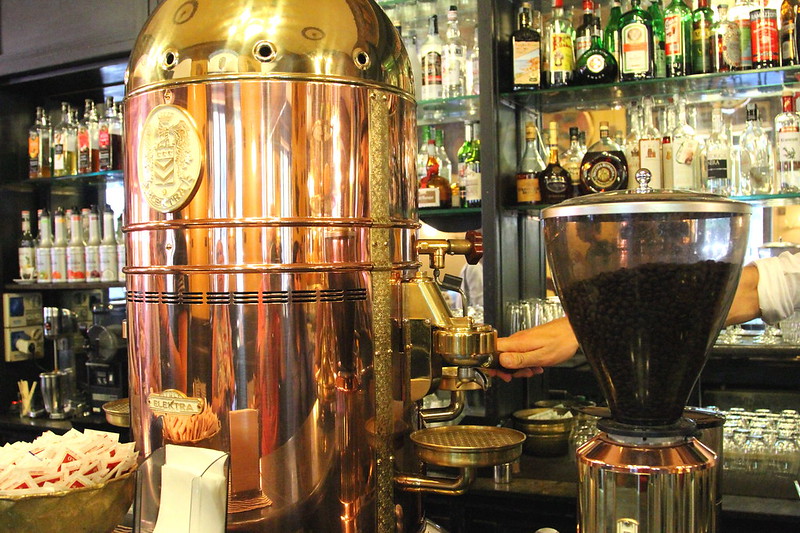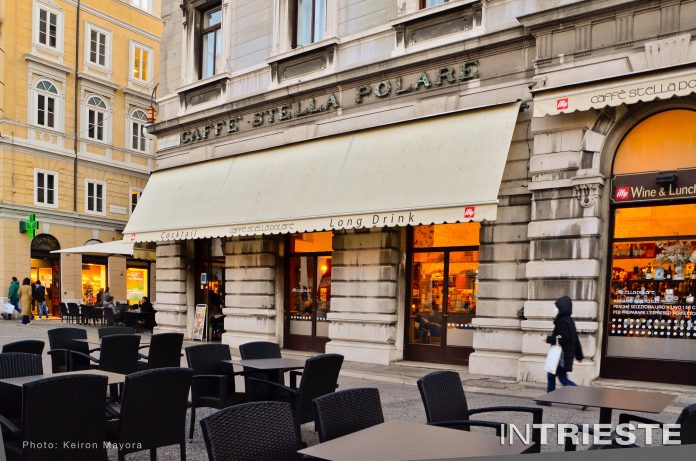by Theodora Negrea
Witnesses to centuries of history. Incubators of cultural, artistic, and social movements. Symbols of democratized access to information, debate, and socialization. Historical cafes are a unique feature of European and Italian culture.
Trieste hosts five such spaces, the oldest of its kind being Caffè Tommaseo opened in 1830, with four other locations in strategic places around the city centre: Antico Caffè San Marco in Via Cesare Battisti, Caffè Stella Polare in Via Dante Alighieri, Antico Caffè Torinese in Corso Italia, and Caffè degli Specchi in Piazza Unità.
Walking into any of these one is instantly charmed by the elegant interiors – in Vienna Secession or Liberty styles – the somewhat ceremonial service, and the diverse typologies of visitors, ranging from cruise-ship tourists to local students, professors or, more recently, digital nomads.
But beyond simply being another tourist attraction to tick through, learning about the history and grounding principles of these places can offer a new perspective on what makes them unique. As well as give you some food for thought (if you excuse the pun) next time you take a sip of your coffee.
These third spaces, as labeled by anthropologist Ray Oldenburg, fit somewhere in-between public and private spheres. They allow for both quiet reflection and lively socialization with friends and strangers alike. Social status matters less here, making it both possible to be anonymous among other visitors and familiar with the regular staff.
Trieste, as a city with a history of exchanges and contrasts, offers a unique opportunity for immersing ourselves in the past and present of Italian culture through 5 historical cafes. Let’s discover them together.

Caffè Tommaseo
Positioned facing the Adriatic Sea, Caffè Tommaseo is one of the 35 buildings in Italy linked to the Risorgimento (the 19th-century movement for Italian unification). Its political meaning emerges even before entering. Outside, a metal plaque reads:
“In 1848, the spark of enthusiasm for Italian freedom spread from this Caffè Tommaseo, the center of a nationwide movement”
James Joyce, Italo Svevo, Franz Kafka, Umberto Saba, and Stendhal were among the regular visitors, as were many other artists, lawyers, academics, and journalists. Forced to change its name a few times through the years due to political pressures, the Caffè now largely maintains its original atmosphere, including the beautiful statues and mirrors brought directly from Belgium.

Caffè Degli Specchi
Owing its name to the old practice of marking key events on the windows and mirrors present in the locale, of which only a few remain today, Caffè Degli Specchi (Caffè of the mirrors) was throughout history a cultural hub, a caffè concerto with its own orchestra, a place of political militancy, and at some point even headquarters of the British Marine. Since its conception, it catered to a clientele of business owners and merchants due to its proximity to the port.
The Caffè offers today a stunning view over Piazza Unità but also a reminder of events that shaped the city in the way it is today.

Antico Caffè San Marco
Hosting the San Marco bookshop since 2013, Antico Caffè San Marco is another of Trieste’s witnesses, and shapers, of history.
In 1914, the Caffè became a clandestine printing house of false passports for Italian patriots opposing Austrian rule. At the time, it had bravely embraced its political stance – at a closer look, many details of the interiors speak of strong irredentist support.
Next time you visit, look up towards the ceiling. From there, red coffee beans hanging from green branches on a white wall used to not-so-subtly allude to the colors of the Italian flag. And if you turn your gaze to the details on some of the tables and furniture, you’ll spot appearances of the San Marco lion, a symbol of Venice.
Same as Caffè Tommaseo, Caffè San Marco saw periods of opposition from the political regimes of the time and was left in a state of abandonment for 30 years. Perhaps more than any of the other Caffès in the city, San Marco represented a democratic meeting space for various religions, age groups, and cultures; a fact also highlighted by the provision of local and foreign newspapers available for consultation, free of charge.
Today, Caffè San Marco hosts numerous events, from book presentations to our expat events, being a true hub of exchange and culture.

Antico Caffè Torinese
With a more modern twist compared to its local siblings, Caffè Torinese opened in 1919 under the concept of Giuliano Debelli, known for its work on luxury transatlantic cruises Saturnia and Vulcania. In 2014, it changed management and expanded its focus on mixology, charmingly marrying past and present as one of Trieste’s most popular cocktail bars. The interior still maintains the original wooden counter, and a golden plate attests to Caffè Torinese’s place as one of Italy’s historical locali.

Caffè Stella Polare
Last but not least, Caffè Stella Polare. Originally called Caffè Gioberti, it was established in 1865 and was well-liked by German merchants. It gained more popularity during the Anglo-American occupation when it hosted dance evenings frequented by soldiers and locals. Today, the Caffè has largely lost its original interior but is nonetheless a worthy attraction. Here you can visit various temporary exhibitions or admire the sunset over the Ponte Rosso canal.
The future of Italian Caffè culture
With the rise of tourism, some voices point to how the culture of the Italian Caffès is gradually being diluted, becoming more focused on profit than on keeping the principle of democratic access intact. After all, one may note how a Coca Cola for 9 euros in some of Italy’s historical Caffès is hardly a symbol of equal access.
But examples of spaces that continue the original long-held ethos still exist. One Caffè in Montepulciano, in the Province of Siena, offers discounted prices to university students. And today still, throughout Italy, the price for drinks consumed al bancone (at the counter) is much lower than that for those consumed at the table.
Some Caffès in Italy still follow an old tradition, the so-called caffè sospeso, which involves buying an extra coffee for those that may otherwise be unable to pay for it. This principle of democratic access also applies to the time spent in the Caffè. The expectation that one needs to constantly order to keep rights of a table from which to peacefully work or read for a few hours doesn’t apply in Italy.
But what about the future? Will Caffès, with a capital C, continue to be the cornerstone of local life and the living rooms of the city? Or will they slowly be dying out as the world becomes more digitalized, as laptops and tablets replace books and live conversations? Caffès are not only places for entertainment or consumption. They are sanctuaries of free thought, stages for debates, political movements, and ideas exchange. They strive to offer each of us the freedom to be whoever we want to be. Some of that, arguably, has already been lost.
Undoubtedly, the role of Caffès may shift with time, but if history is telling us anything, it’s that these spaces will continue to be central hubs of expression as the world and our societies continue to change. If anything, in a world where we have become used to canceling each other’s views, such spaces are more important than ever.
One simple thing you can do is go visit these places with renewed awe, acknowledging the role they had and continue to have. Head to one of these Caffès, grab a book and watch the world go by. You may just be witnessing history.
This article was largely inspired by a passion for literary cafes, an instant love for Caffè San Marco upon visiting it for the first time in July 2020, and the insightful book, ‘Andare per Caffe Storici’ by Massimo Cerulo, which I warmly recommend to anyone interested in learning more about the history of these fascinating spaces. Special thanks also to the book author for an inspiring discussion held at Cafe San Marco on the 3rd November 2021, where the issue of democratic access came up, as well as to one audience member who mentioned the Montepulciano example and rightly put the spotlight on the issue of prices and access.





























